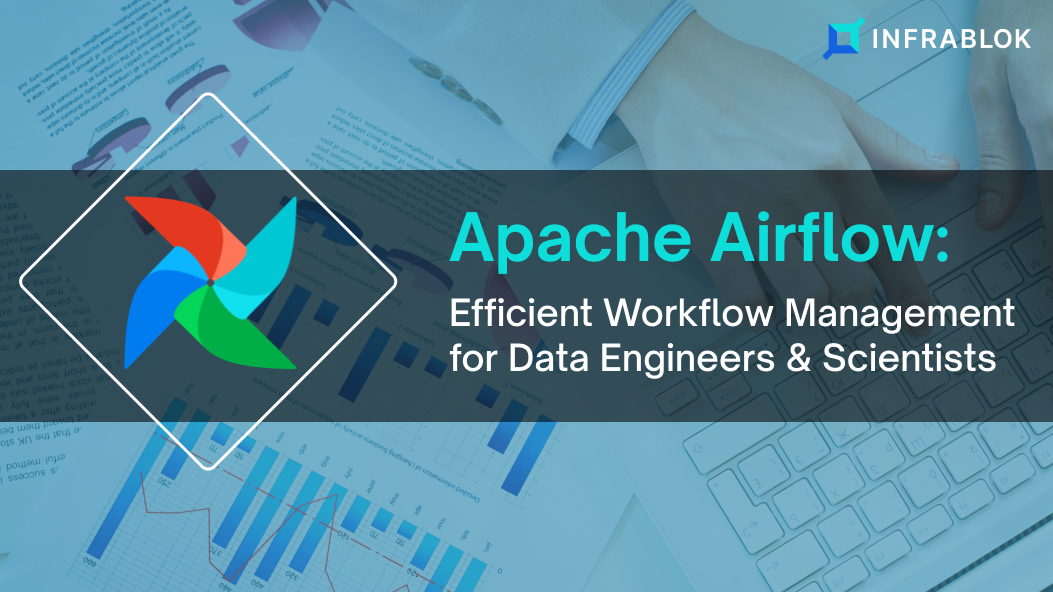In the world of data engineering and data science, efficient workflow management is the secret ingredient that makes everything run smoothly. Imagine having a magical tool that automates and orchestrates all those complex data processing tasks, ensuring they happen in the right order, at the right time, and without any hiccups. Well, say hello to Apache Airflow! It’s like the conductor of an orchestra, ensuring every note is played perfectly.
So, what is Apache Airflow?
It’s an open-source platform that Python programmers like us can use to define, schedule, and monitor workflows with ease. With Airflow, we can wave goodbye to tedious manual management and embrace the power of automation, scalability, and visibility.
In this blog, we’re going to take a deep dive into Apache Airflow and explore how it empowers us, Python programmers, to be workflow wizards, making our data engineering and data science tasks a breeze to manage.
Get ready to unlock the magic of efficient workflow management with Airflow!
Apache Airflow Overview
Airflow is built upon the foundation of Directed Acyclic Graphs (DAGs), which are like the magical blueprints that guide the flow of data. DAGs provide the structure and logic for workflows, ensuring tasks are executed in the right sequence, free from the clutches of cyclic dependencies. They are the enchanted roadmaps that lead us to the land of efficient data processing.
But Airflow is more than just a collection of spells and enchantments. It boasts a magnificent ensemble of components that work together seamlessly. The scheduler, a master of time manipulation, coordinates when tasks should be executed, orchestrating the rhythm of our workflows. The Executor, a true multitasking wizard, handles the execution of tasks across multiple workers, unlocking the power of parallelism.
And let’s not forget the incredible Web UI, a portal to the magical world of Airflow. With its intuitive interface and visual representation of DAGs, it grants us a bird’s-eye view of our workflows, allowing us to monitor and track their progress with the flick of a wand. Accompanying the Web UI is the Metadata Database, a treasure trove of information that stores the state and history of our workflows, ensuring we have a reliable record of every spell cast.
In this mystical journey, we will embark on a quest to unravel the secrets of each component, diving deep into its enchanting capabilities. So, don your robes, wield your wand (or keyboard), and join us as we unravel the incredible world of Apache Airflow, where workflows come to life and data dances to the tune of our command. Prepare to be spellbound by the magic of Airflow!
Steps For Setting Up Apache Airflow
The time has come to embrace the capabilities of Apache Airflow and begin the adventure of streamlined workflow management. Rest assured, the path to enlightenment is made easy with straightforward installation and configuration instructions designed for both Windows and Linux environments.
1. Installation and configuration steps for Airflow
In the incredible land of Windows, let us begin our journey with the following incantations:
# Create a virtual environment (optional but recommended) python -m venv airflow-env # Activate the virtual environment .\airflow-env\Scripts\activate # Install Apache Airflow pip install apache-airflow
And lo and behold Linux travelers, your path unfolds with these mystical commands:
# Create a virtual environment (optional but recommended) python3 -m venv airflow-env # Activate the virtual environment source airflow-env/bin/activate # Install Apache Airflow pip install apache-airflow
With the installation complete, the true magic of Airflow begins to reveal itself. But first, we must embark on the path of configuration. Fear not, for the journey is not treacherous. In fact, it is as simple as a gentle whisper:
For Windows wizards, make your way to the command line and enter the following spells:
# Initialize the metadata database airflow db init # Create an admin user (follow the prompts) airflow users create # Start the Airflow web server airflow webserver # Start the scheduler airflow scheduler
And for the mystical Linux sorcerers, utter these words of power:
# Initialize the metadata database airflow db init # Create an admin user (follow the prompts) airflow users create # Start the Airflow web server airflow webserver --port 8080 # Start the scheduler airflow scheduler
Now, with Airflow coursing through your veins, let us take a moment to appreciate the hidden chambers where Airflow’s configuration secrets reside. Windows enchanters seek solace in the following directory:
C:\Users\YourUsername\airflow
And Linux mystics venture into the ethereal realm of:
/home/YourUsername/airflow
Within these sacred directories lie the configuration files that shape Airflow’s behavior, allowing you to unleash the true power of your workflows.
So, my fellow practitioners of the magical arts, we have taken the first steps in our quest for efficient workflow management. The spells of installation and configuration have been cast, and the stage is set for us to wield the power of Apache Airflow. Now, let us proceed on our journey, where we will dive deeper into the realms of DAGs, task dependencies, and the art of orchestrating workflows. May the magic of Airflow guide our way as we unlock the secrets of efficient workflow management!
2. Overview of the directory structure and configuration files
Welcome, brave adventurers, to the magical labyrinth of Apache Airflow! As we delve deeper into this mystical realm of workflow management, let us uncover the secrets of Airflow’s directory structure and the powerful configuration files that shape its very essence.
Behold as we embark on a wondrous journey through the enchanted directories!
DAGs
A realm where DAGs (Directed Acyclic Graphs) come to life! In this chamber, Python sorcerers like you will craft spells of logic, defining the tasks and their dependencies within your workflows. Each Python file within this domain represents a unique and awe-inspiring DAG, ready to unleash its power upon the world.
Plugins
Ah, the treasury of magical artifacts! Here, you shall find a collection of custom plugins and extensions waiting to be discovered. These extraordinary components, be they operators, hooks, sensors, or macros, empower you to summon additional functionality and weave it seamlessly into your workflows.
Config
The heart of Airflow’s configuration whispers its secrets within this sacred chamber. Here, behold the mighty airflow.cfg, a file containing an arsenal of settings that shape Airflow’s behavior. From defining your DAGs’ location to configuring task retries’ behavior, this magical artifact allows you to tailor Airflow to your desires.
Logs
Like the ethereal echoes of spells cast, this ethereal realm cradles the logs of your Airflow executions. It is here that you will find a record of your workflow’s journey, enabling you to trace its steps and unveil any hidden enchantments or anomalies that may have transpired.
Scripts
A realm where scripts hold the power to administrate and manage Airflow. Invoke these scripts and witness their conjuring as they perform mystical tasks such as database migrations or backups. With these scripts, you command the forces of Airflow to align with your desires.
Tests
A proving ground for aspiring wizards, where the strength of your Airflow configurations and workflows shall be tested. Craft tests within this realm, ensuring that your magical creations endure the crucible of reliability and correctness.
Now, let us wield our powers in the realms of Windows and Linux as we summon the commands and code snippets necessary to navigate these directories:
For Windows sorcerers, invoke these commands in your command prompt:
# View the contents of the directory dir # Change to the DAGs directory cd airflow\dags # Change to the plugins directory cd airflow\plugins # Change to the configuration directory cd airflow\config # Change to the logs directory cd airflow\logs # Change to the scripts directory cd airflow\scripts # Change to the tests directory cd airflow\tests
And for the Linux wizards, embrace the power of these commands in your terminal:
# View the contents of the directory ls # Change to the DAGs directory cd airflow/dags # Change to the plugins directory cd airflow/plugins # Change to the configuration directory cd airflow/config # Change to the logs directory cd airflow/logs # Change to the scripts directory cd airflow/scripts # Change to the tests directory cd airflow/tests
Within these captivating directories, you shall uncover the true essence of Airflow’s configuration. Open the airflow.cfg file and witness the incantations that allow you to shape the behavior of Airflow to suit your needs. From global settings to connection details and beyond, this magical artifact holds power to manifest your intentions.
3. Introduction to the Airflow command-line interface (CLI)
Greetings, intrepid adventurers, for we are about to unlock the true power of Apache Airflow through the mystical command-line interface (CLI). With a flick of your fingers and a few carefully crafted commands, you shall command Airflow to dance to your whims. Let us embark on this journey and become masters of the Airflow CLI.
In the realm of Windows, open your command prompt and prepare to utter the following incantations:
# Activate the virtual environment (if applicable) .\airflow-env\Scripts\activate # View the available Airflow commands airflow list # Trigger a DAG manually airflow trigger_dag DAG_ID # Pause a DAG airflow pause DAG_ID # Unpause a DAG airflow unpause DAG_ID # Backfill a DAG from a specific start date airflow backfill DAG_ID --start_date START_DATE # Restart a failed task airflow clear DAG_ID --task_regex TASK_REGEX --start_date START_DATE --end_date END_DATE
Fear not, for Linux images; your path unfolds with these powerful spells:
# Activate the virtual environment (if applicable) source airflow-env/bin/activate # View the available Airflow commands airflow list # Trigger a DAG manually airflow trigger_dag DAG_ID # Pause a DAG airflow pause DAG_ID # Unpause a DAG airflow unpause DAG_ID # Backfill a DAG from a specific start date airflow backfill DAG_ID --start_date START_DATE # Restart a failed task airflow clear DAG_ID --task_regex TASK_REGEX --start_date START_DATE --end_date END_DATE
With these commands, you gain the power to control Airflow’s every move. Trigger a DAG to initiate its execution, pause it when necessary, or unleash its full potential by unpausing it. Marvel at the ability to backfill a DAG from a specific start date, allowing you to catch up on missed executions. And should a task stumble, fear not, for you can restart it with the precise touch of a clear command.
But the CLI is not limited to these commands alone. It is a gateway to a realm of endless possibilities. With the Airflow CLI, you can create connections to external systems, manage variables, view logs, and even interact with the powerful Airflow web interface. The CLI is your wand; with it, you wield the magic of Airflow.
So, my fellow sorcerers of the command line, let us embrace the Airflow CLI and unlock its vast potential. We shape our workflows with each command, orchestrate our data pipelines, and manifest efficiency and power. Step forth, and let the Airflow CLI become an extension of your will, for within it lies the ability to conquer the realm of workflow management.
Defining Data Pipelines with Airflow
Welcome, brave adventurers, to the realm of Apache Airflow, where data pipelines flourish like enchanted gardens. In this mystical land, we shall uncover the secrets of defining and orchestrating these wondrous pipelines using the powers bestowed upon us by Airflow. Prepare yourselves, for we are about to embark on a journey filled with magical code snippets and commands that will bring data to life.
1. DAGs & Tasks In Airflow
In the incredible world of Airflow, DAGs (Directed Acyclic Graphs) reign supreme. These spellbinding constructs serve as the blueprints for our data pipelines, defining the order and dependencies of tasks. Within the depths of our DAGs lie the tasks, each a distinct unit of work waiting to be summoned into existence.
To comprehend the essence of DAGs and tasks, let us invoke the commands that guide us through this magical realm.
For Windows wizards, embark on this path within your command prompt:
# Activate the virtual environment (if applicable) .\airflow-env\Scripts\activate # Navigate to the directory where your DAGs reside cd airflow\dags
And for the Linux sorcerers, embrace the power of these commands in your terminal:
# Activate the virtual environment (if applicable) source airflow-env/bin/activate # Navigate to the directory where your DAGs reside cd airflow/dags
Now, imagine a wondrous Python script that encapsulates the essence of a DAG, bringing it to life. Witness the power of defining tasks and their dependencies as we embark on a captivating example:
from datetime import datetime from airflow import DAG from airflow.operators.bash import BashOperator # Create a new DAG dag = DAG( "my_data_pipeline", description="A mystical data pipeline", start_date=datetime(2023, 1, 1), schedule_interval="@daily", ) # Define our magical tasks task_1 = BashOperator( task_id="task_1", bash_command="echo 'Task 1 is complete'", dag=dag, ) task_2 = BashOperator( task_id="task_2", bash_command="echo 'Task 2 is complete'", dag=dag, ) task_3 = BashOperator( task_id="task_3", bash_command="echo 'Task 3 is complete'", dag=dag, ) # Set the dependencies between tasks task_1 >> task_2 >> task_3
2. Tasks and their dependencies using Python code
With the power of Python code, we can now define the tasks that constitute our data pipeline. Each task is represented by an operator, a magical entity that carries out a specific action. By defining these tasks and their dependencies, we create a spellbinding flow of data processing.
Within the code snippet above, we see the creation of three tasks using the BashOperator from Airflow’s extensive collection of built-in operators. These tasks invoke simple bash commands, echoing their completion like whispers in the wind.
To establish the dependencies between tasks, we use the >> operator, forming an elegant chain of execution. In our example, task_1 must complete before task_2, and task_2 must complete before task_3.
Airflow’s Built-In Operators & Their Use Cases
Airflow bestows upon us a vast repertoire of built-in operators, each designed to perform specific actions and interact with various systems. These operators serve as the building blocks of our data pipelines, allowing us to summon their powers and weave them into our DAGs.
Let us embark on a brief overview of some prominent Airflow use cases and operators:
1. BashOperator
A versatile operator that executes bash commands, allowing us to interact with the underlying system and perform a wide range of operations. It enables us to run shell scripts, invoke command-line tools, and execute custom commands within our data pipelines.
2. PythonOperator
This magical operator empowers us to execute arbitrary Python code within our tasks. It opens the doors to endless possibilities, enabling us to perform complex data transformations, invoke external Python libraries, or even integrate machine learning models into our pipelines.
3. SQLAlchemyOperator
With this operator, we can execute SQL queries against a variety of databases. It facilitates seamless integration with database systems, allowing us to extract, transform, and load data efficiently.
4. S3FileTransferOperator
This operator is specifically designed for working with Amazon S3. It simplifies the process of transferring files to and from S3, enabling seamless integration with cloud storage for data processing and storage.
5. EmailOperator
As the name suggests, this operator allows us to send emails as part of our data pipeline. It can be used to notify stakeholders about job completion, send reports, or trigger alerts when certain conditions are met.
6. DockerOperator
With this operator, we can harness the power of containerization using Docker. It enables us to run tasks within isolated containers, ensuring reproducibility and scalability in our data pipelines.
These are just a few examples of the vast array of operators available in Airflow. Each operator brings unique capabilities, allowing us to interact with different systems, perform specialized tasks, and unleash the full potential of our data pipelines.
As you venture further into the realm of Airflow, you will discover a rich collection of operators tailored to specific use cases. By harnessing their power, you can weave intricate workflows that seamlessly integrate various tools and systems, transforming your data with precision and grace.
So, gather your courage, Python wizards and Linux sorcerers, and dive into the depths of Airflow’s built-in operators. With their great abilities at your disposal, you will conquer the most complex data challenges and craft extraordinary data pipelines.
Ending Words
Efficient workflow management plays a crucial role in the success of data engineering and data science projects. Apache Airflow emerges as a powerful tool that enables organizations to streamline their workflows, automate processes, and optimize data pipelines.
Moreover, by leveraging Airflow’s capabilities, practitioners can optimize their processes, increase productivity, and deliver high-quality results, ultimately driving innovation and success in the data-driven world.
Stay tuned to get more updates regarding Apache Airflow…





